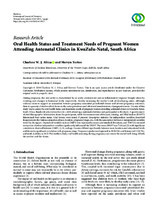| dc.description.abstract | During pregnancy, the oral cavity is characterised by an acidic environment and an inflammatory response brought about by vomiting and changes in hormonal levels, respectively, thereby increasing the mother’s risk of developing caries. Although evidence exists to support an association between pregnancy-associated periodontal disease and adverse pregnancy outcomes, there is a paucity of studies which focus on the caries prevalence and other oral manifestations of pregnant women. The aim of this study was to assess the oral health status and treatment needs of pregnant women attending antenatal clinics in KwaZulu-Natal, South Africa. Randomly selected mothers (n = 443) attending a maternal obstetrics unit participated in the study. A questionnaire elicited demographic information about the participants, while the measurement of decayed, missing, and filled indices (DMFT) determined their caries status. Oral lesions were noted if present. Descriptive statistics for independent variables described frequencies in the various categories of race, location, pregnancy stage, etc., with the association between 2 independent variables tested by chi-square. Dependent variables such as DMFT were expressed as means and standard deviations, and ANOVA was used to examine whether independent variables significantly influenced the DMFT. The mean DMFT was 7.18 (±4.22) with significant correlations observed between DMFT, D, M, and age. F scores differed significantly between races, location, and educational levels and showed a significant correlation with pregnancy stage. Pregnancy epulis was diagnosed in 38 (8.5%), oral lesions in 65 (14.7%), and tooth mobility in 26 (5.9%) mothers. Early oral health screening during pregnancy can ensure the overall well-being of both the mother and the foetus. | en_US |

